Intel Iris Pro 5200 Graphics Review: Core i7-4950HQ Tested
by Anand Lal Shimpi on June 1, 2013 10:01 AM ESTCompute Performance
With Haswell, Intel enables full OpenCL 1.2 support in addition to DirectX 11.1 and OpenGL 4.0. Given the ALU-heavy GPU architecture, I was eager to find out how well Iris Pro did in our compute suite.
As always we'll start with our DirectCompute game example, Civilization V, which uses DirectCompute to decompress textures on the fly. Civ V includes a sub-benchmark that exclusively tests the speed of their texture decompression algorithm by repeatedly decompressing the textures required for one of the game’s leader scenes. While DirectCompute is used in many games, this is one of the only games with a benchmark that can isolate the use of DirectCompute and its resulting performance.
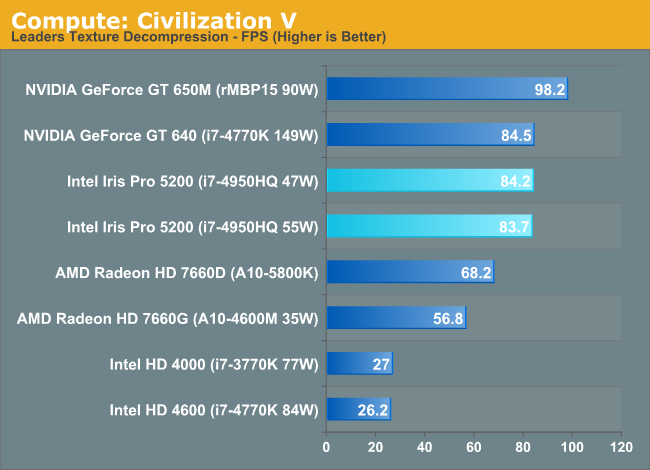
Iris Pro does very well here, tying the GT 640 but losing to the 650M. The latter holds a 16% performance advantage, which I can only assume has to do with memory bandwidth given near identical core/clock configurations between the 650M and GT 640. Crystalwell is clearly doing something though because Intel's HD 4600 is less than 1/3 the performance of Iris Pro 5200 despite having half the execution resources.
Our next benchmark is LuxMark2.0, the official benchmark of SmallLuxGPU 2.0. SmallLuxGPU is an OpenCL accelerated ray tracer that is part of the larger LuxRender suite. Ray tracing has become a stronghold for GPUs in recent years as ray tracing maps well to GPU pipelines, allowing artists to render scenes much more quickly than with CPUs alone.
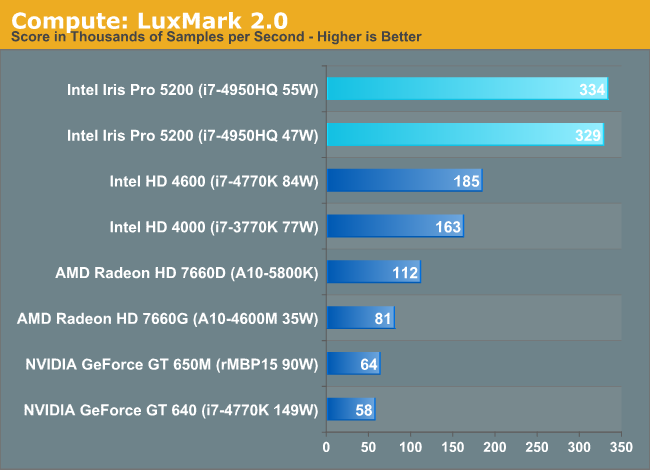
Moving to OpenCL, we see huge gains from Intel. Kepler wasn't NVIDIA's best compute part, but Iris Pro really puts everything else to shame here. We see near perfect scaling from Haswell GT2 to GT3. Crystalwell doesn't appear to be doing much here, it's all in the additional ALUs.
Our 3rd benchmark set comes from CLBenchmark 1.1. CLBenchmark contains a number of subtests; we’re focusing on the most practical of them, the computer vision test and the fluid simulation test. The former being a useful proxy for computer imaging tasks where systems are required to parse images and identify features (e.g. humans), while fluid simulations are common in professional graphics work and games alike.
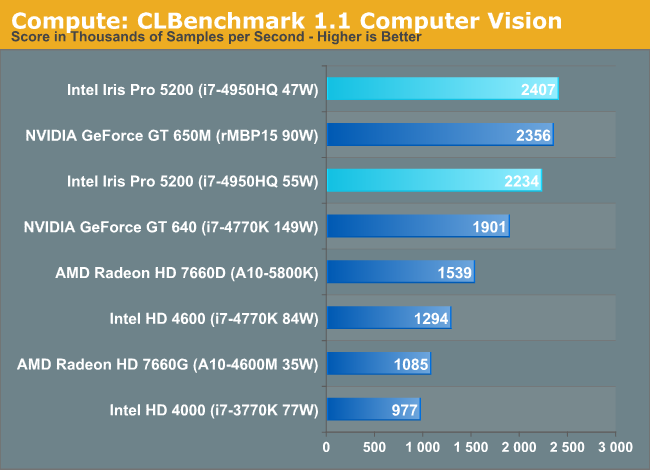
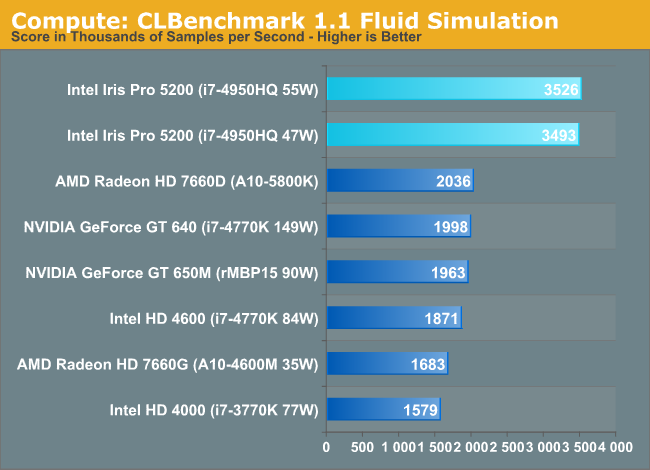
Once again, Iris Pro does a great job here, outpacing everything else by roughly 70% in the Fluid Simulation test.
Our final compute benchmark is Sony Vegas Pro 12, an OpenGL and OpenCL video editing and authoring package. Vegas can use GPUs in a few different ways, the primary uses being to accelerate the video effects and compositing process itself, and in the video encoding step. With video encoding being increasingly offloaded to dedicated DSPs these days we’re focusing on the editing and compositing process, rendering to a low CPU overhead format (XDCAM EX). This specific test comes from Sony, and measures how long it takes to render a video.
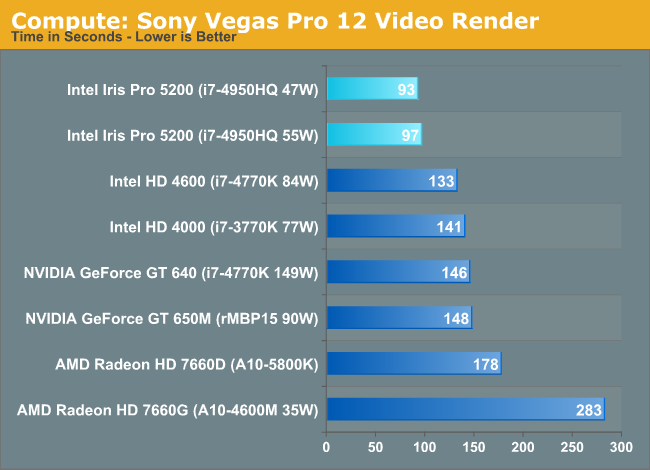
Iris Pro rounds out our compute comparison with another win. In fact, all of the Intel GPU solutions do a good job here.










177 Comments
View All Comments
Elitehacker - Tuesday, September 24, 2013 - link
Even for a given power usage the 650M isn't even to on the top of the list for highest end discrete GPU.... The top at the moment for lowest wattage to power ratio would be the 765M, even the Radeon HD 7750 has less wattage and a tad more power than the 650M. Clearly someone did not do their researching before opening their mouth.I'm gonna go out on a limb and say that vFunct is one of those Apple fanboys that knows nothing about performance. You can get a PC laptop in the same size and have better performance than any Macbook available for $500 less. Hell you can even get a Tablet with an i7 and 640M that'll spec out close to the 650M for less than a Macbook Pro with 650M.
Eric S - Tuesday, June 25, 2013 - link
The Iris Pro 5200 would be ideal for both machines. Pro users would benefit from ECC memory for the GPU. The Iris chip uses ECC memory making it ideal for OpenCL workloads in Adobe CS6 or Final Cut X. Discrete mobile chips may produce errors in the OpenCL output. Gamers would probably prefer a discrete chip, but that isn't the target for these machines.Eric S - Monday, July 1, 2013 - link
I think Apple cares more about the OpenCL performance which is excellent on the Iris. I doubt the 15" will have a discrete GPU. There isn't one fast enough to warrant it over the Iris 5200. If they do ever put a discrete chip back in, I hope they go with ECC GDDR memory. My guess is space savings will be used for more battery. It is also possible they may try to reduce the display bezel.emptythought - Tuesday, October 1, 2013 - link
It's never had the highest end chip, just the best "upper midrange" one. Above the 8600m GT was the 8800m GTX and GTS, and above the 650m there was the 660, a couple 670 versions, the 675 versions, and the 680.They chose the highest performance part that hit a specific TDP, stretching a bit from time to time. It was generally the case that anything which outperformed the MBP was either a thick brick, or had perpetual overheating issues.
CyberJ - Sunday, July 27, 2014 - link
Not even close, but whatever floats you boat.emptythought - Tuesday, October 1, 2013 - link
It wouldn't surprise me if the 15in just had the "beefed up" iris pro honestly. They might even get their own, special even more overclocked than 55w version.Mainly, because it wouldn't be without precedent. Remember when the 2009 15in macbook pro had a 9400m still? Or when they dropped the 320m for the hd3000 even though it was slightly slower?
They sometimes make lateral, or even slightly backwards moves when there are other motives at play.
chipped - Sunday, June 2, 2013 - link
That's just crazy talk, they want drop dedicated graphics. The difference is still too big, plus you can't sell a $2000 laptop without a dedicated GFX.shiznit - Sunday, June 2, 2013 - link
considering Apple specifically asked for eDRAM and since there is no dual core version yet for the 13", I'd say there is very good chance.mavere - Sunday, June 2, 2013 - link
"The difference is still too big"The difference in what?
Something tells me Apple and its core market is more concerned with rendering/compute performance more than Crysis 3 performance...
iSayuSay - Wednesday, June 5, 2013 - link
If it plays Crysis 3 well, it can render/compute/do whatever intensive fine.